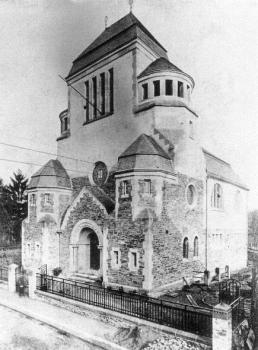
The first references to a prayer room in Wittlich originated in the early 19th Century, when the fellowship was still conducting worship services in a private home. They eventually purchased a section of the old hospital church in 1831 to convert it into a synagogue.
The Jewish community then purchased several tracts of land on the “Himmeroder Straße” at the end of the 19th Century, on which an impressive ritual structure was built. It was dedicated in November 1910, drawing a high degree of attention from, and the participation of the entire city.
During the Novemver pogroms of 1938, 20 to 30 local residents and non-local SA henchmen forced their way into the synagogue and demolished it with axes and hammers. Ritual objects were thrown into the street, but an arson attack was prevented thanks to the efforts of the city’s mayor. The building was sold to the city of Wittlich in 1939 and served as a prisoner of war camp between 1940 and 1945.
The building was eventually ceded to the Jewish religious and cultural community of Trier as legal successor in 1950. Nevertheless, because it was left unused, the synagogue eventually fell into disrepair until the city of Wittlich purchased it in 1975 to initiate the necessary repairs and restoration work. Since that time, the building has served as a cultural and conference centre. This structure represents the largest surviving synagogue in the state of Rhineland-Palatinate and was placed under protection as a historical monument in 1997.
Photo documentation: Historical photo of the new synagogue. “Landesamt für Denkmalpflege Rheinland-Pfalz” (Rhineland-Palatinate state office for the preservation of historic landmarks), Synagogues of Rhineland-Palatinate - Saarland (Mainz 2005) Pg. 392, Alemannia Judaica
